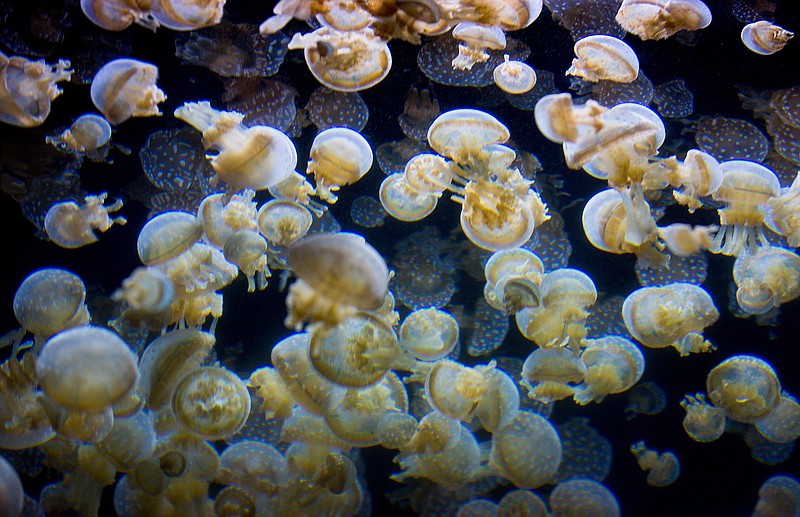HOUSTON-Tucked away in an unseen corner of the Houston Zoo, a 5-gallon bucket-called the "romantic weekend getaway" by those in the know-sits in an open-air tank filled with saltwater.
There, adult jellyfish spend their days in close proximity, releasing eggs and sperm that hopefully meet up and eventually turn into polyps that attach to the plastic sides of the pail.
The Houston Chronicle reports it's just the beginning stages of the monthslong, sometimes yearslong, process of hand-rearing these Medusa-like, gelatinous creatures in captivity, a method that the Houston Zoo began perfecting about 10 years ago.
"You have to be very patient," Becky Futch, the zoo's resident jelly keeper, said with a laugh.
It might seem like a counterintuitive process: Most beachgoers curse the jellies' existence as they pick their way through the debris that washes up on the sandy shoreline, hopeful they don't feel the sometimes venomous sting of these creatures. But the constant upkeep of the jellyfish population is all part of the educational experience the zoo seeks to provide.
At any given time, there are thousands-if not hundreds of thousands-of jellies at various stages of development in Futch's care, all awaiting the day when they might be deemed both healthy and large enough to go on display in the zoo's aquarium.
The cycle is nonstop, Futch said, because jellyfish have such short lifespans. On average, they live about six months to a year-two at most.
But Futch is unsure if jellies experience the same short lifespan in the wild as they do in captivity.
"They live a decent amount of time" in captivity," Futch said. But "there's no way to track a wild jellyfish to see how long it lives."
Aquariums began breeding jellyfish in the 1930s, but the techniques were not very reliable until 30 years later, according to the World Economic Forum.
By that time, scientists had discovered that rounded glass tanks with slowly moving water made a perfect home for jellyfish, the forum reports, and breeding programs began to crop up throughout Germany, the United States and Japan.
Though the practice is now more common, each zoo and aquarium does it differently.
In Houston, zoo officials allow jellyfish polyps the size of a pinhead to hook onto the sides of water-filled buckets-and any structures they place inside the tubs-where they resemble teeny tiny coral reefs or sea anemone.
Depending on the species, Futch will let a few days, weeks or even months pass before she begins subjecting the polyps to stressors that mimic what they might experience in the wild.
To mimic tidal waves, Futch will remove the polyps from water that is 60 degrees Fahrenheit and place them in 74-degree water. She also will withhold feedings for a few days and then flush their tank with extra food-usually brine shrimp cultivated onsite-fluctuations that occur frequently in the wild.
These stressors force the tops of the polyps-known as ephyra-to detach from their stump. The ephyra look, quite literally, like itty bitty adult jellyfish pulsing through the water with their umbrella-shaped bodies.
Futch has jelly breeding down to such an exact science that she can keep the number of ephyra produced to about 50 per week-the zoo doesn't have enough room for much more than that, she said.
By the time the jellyfish are about the size of a quarter, they are ready to be placed in the display tanks at the zoo. Sometimes that growth takes two months, but it can take much longer.
"I like to think of it like making cookies," she said. "If you try to make too many cookies at one time, you wreck them all. So usually those guys go through and we switch out those 50 for ones on display."
As the drone of water constantly cycling through pumps reverberates through the building, Futch affectionately watches her quarter-sized lagoon jellies on a recent Thursday morning.
They've developed the white spots on their bodies characteristic to their species, and their oral arms are fully developed.
This crop of 50 or so jellies were just about ready to go on display.
Soon, Futch would begin the process of cycling out the older lagoon jellyfish from their display tank on the zoo grounds, introducing these young ones into it. It was about time for a switch, she said, as some of those on display were exhibiting end-of-life signs.
Some were struggling to stay afloat, sinking to the bottom of the tank. Others were folding into a taco shape, unable to keep their intended form. Still others were getting stuck to the sides of the tank, causing problems for the other jellies pulsing through the water.
When this happens, zoo personnel follow requirements laid out by the Association of Zoos and Aquariums in removing the dying jellies. First they take them out of the tank in a bag full of the tank's water, Futch said, which is then frozen into a block of ice. Once frozen, certain jellyfish are chopped up and fed to others, if that's what their diet stipulates.
It's a constant cycle of life and death for these creatures, forcing Futch to remain on her toes in order to keep the zoo's stock of jellyfish plentiful and healthy.
"It's a process," she said.

